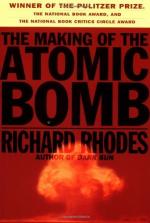|
This section contains 1,059 words (approx. 3 pages at 400 words per page) |

|
The Scientists
Rhodes describes extensively, up to World War II, the lives and work of an international community of scientists, mostly physicists and chemists, whose work eventually culminated in the making of the first atomic bomb. Theories of the existence of atomic particles date back to Greek philosophy in the fifth century B.C., and, by the seventeenth century A.D. most scientists assumed the existence of the atom. However, no actual proof of the existence of the atom had been formulated until J. J. Thomson discovered the electron in 1897. In 1884, Thomson was chair of the distinguished Cavendish Laboratory at Cambridge where he exerted tremendous influence on a generation of scientists. Einstein's revolutionary theory of relativity was announced in 1915. Leo Szilard, a Hungarian-born Jewish theoretical physicist, entered the University of Berlin in 1921, where he collaborated with Einstein. Ernest Rutherford was a New Zealand born British physicist credited with...
|
This section contains 1,059 words (approx. 3 pages at 400 words per page) |

|




